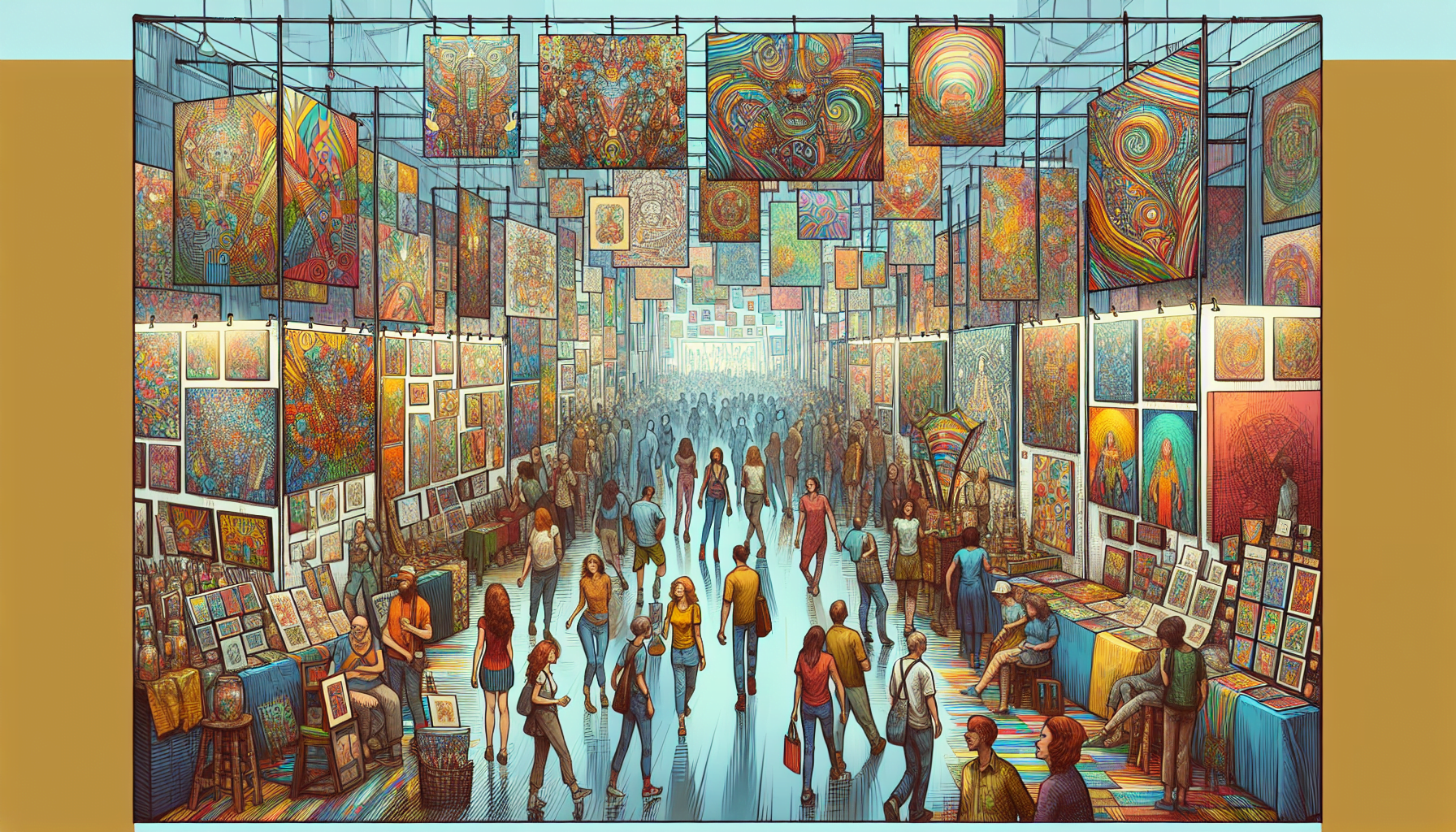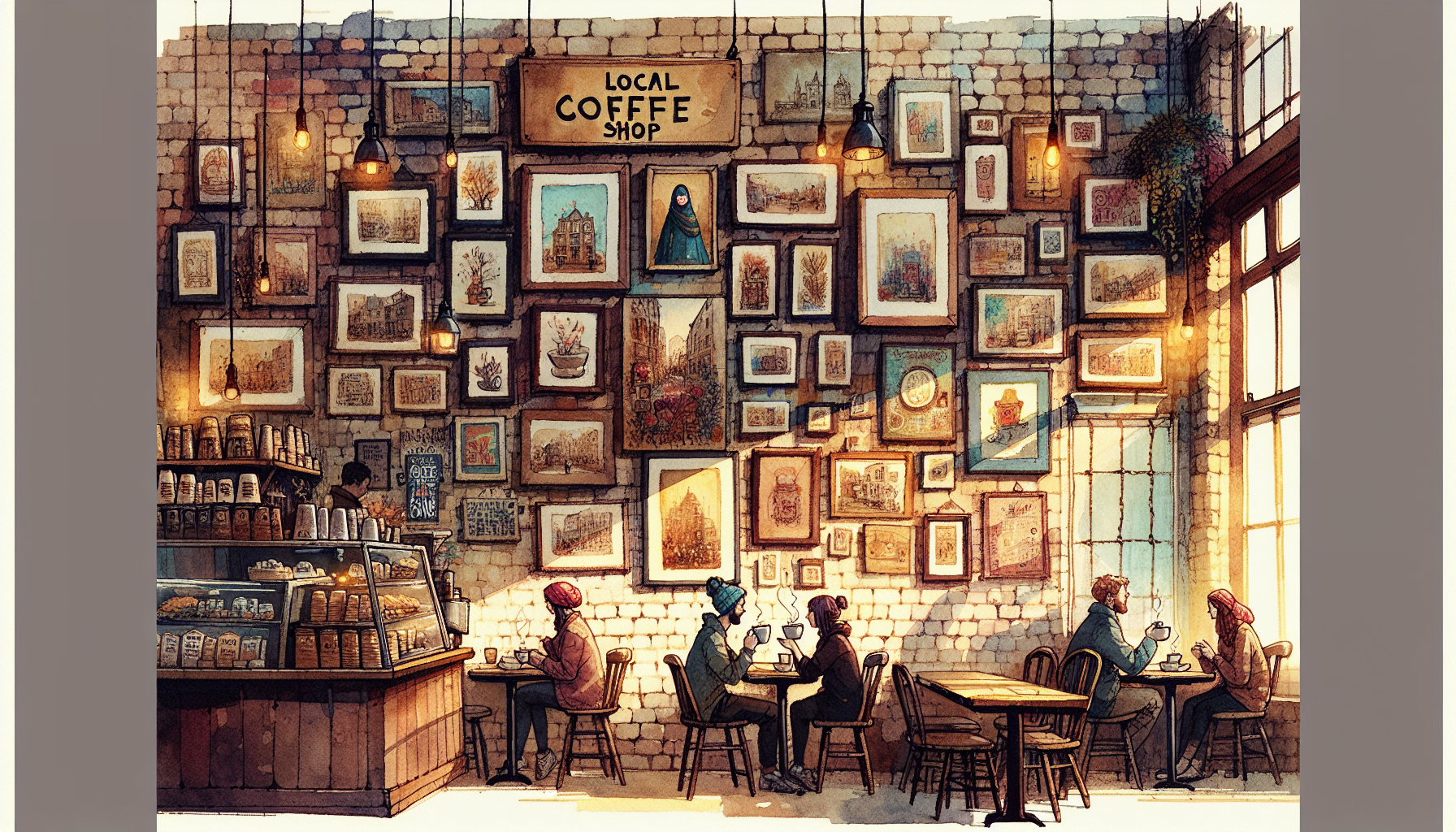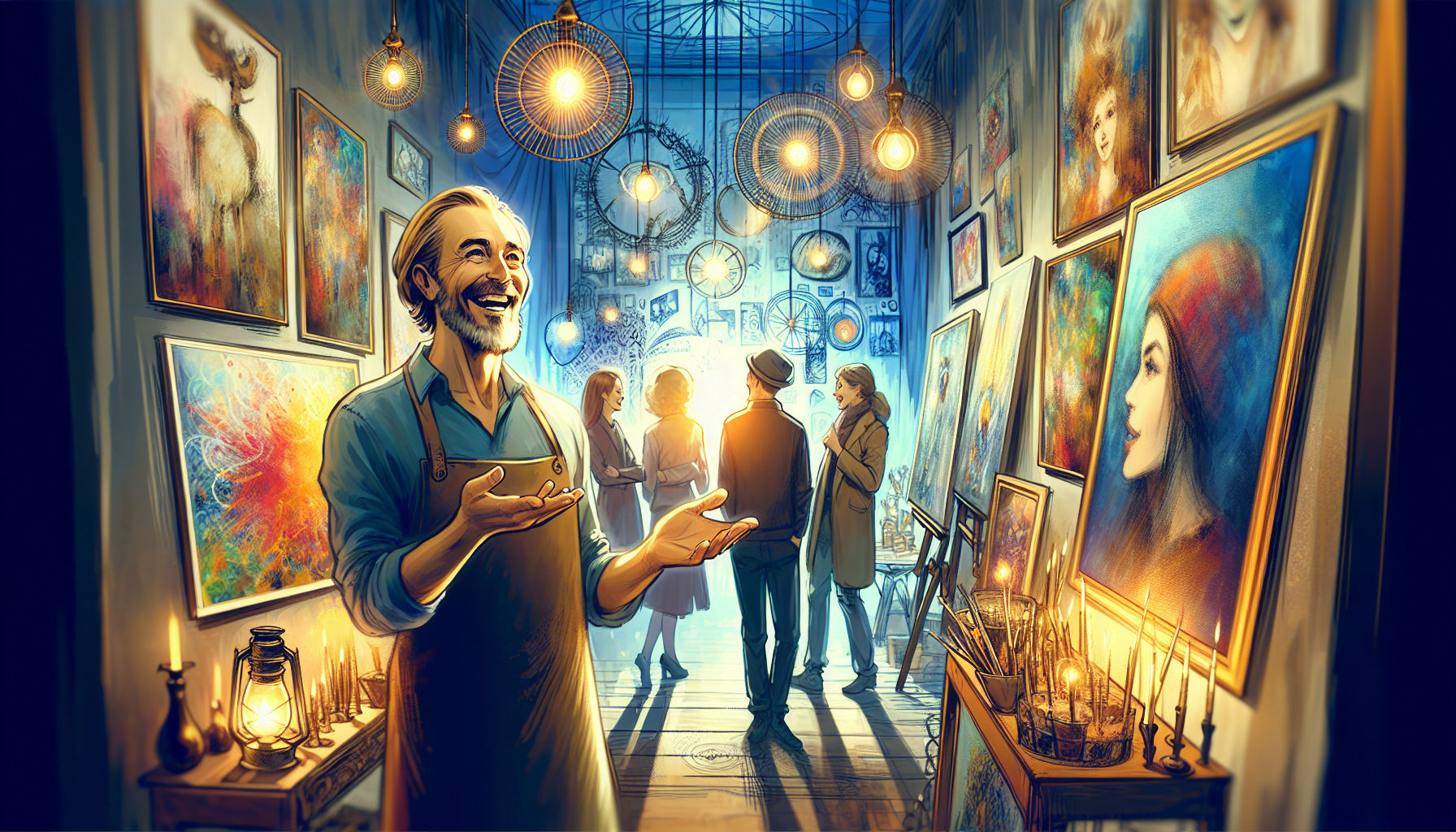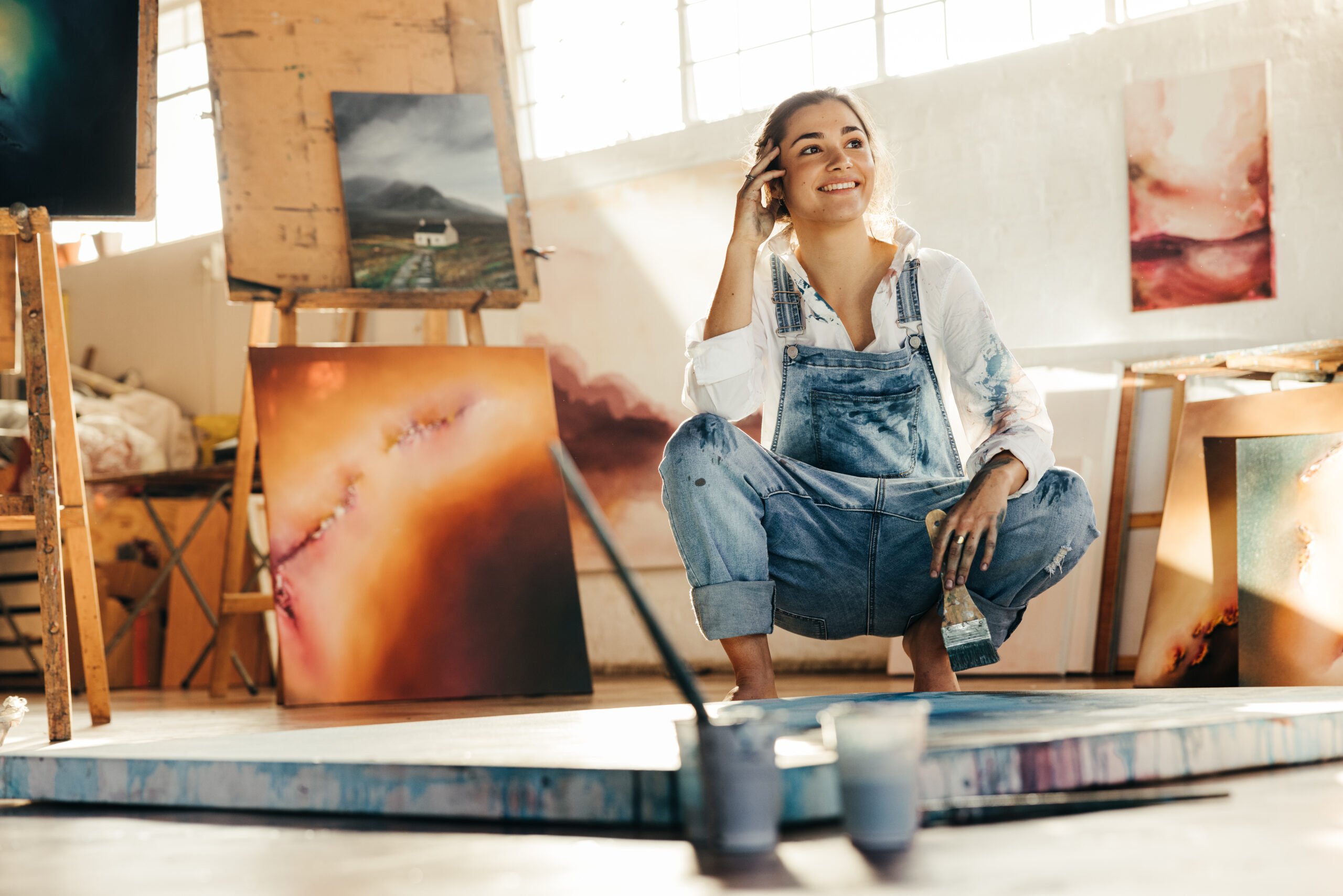If you’re an artist wondering how to sell your art locally, this no-fluff guide is for you. From navigating local art fairs to forming strategic partnerships and boosting your social media game, we’ll walk you through the concrete steps and savvy strategies for turning your local art scene into your canvas for success. Discover the keys to connecting with buyers and carving out your niche in the local art market.
Key takeaways
Artists can optimize local market presence by engaging in local art fains and festivals, exhibiting in coffee shops, collaborating with businesses, creating pop-up galleries, participating in community projects, and offering workshops.
Effective strategies for success include selecting the right venues, creating an inviting booth, employing sales and networking strategies, leveraging social media, and engaging authentically with the local art scene and followers.
Diversifying efforts by collaborating with other artists, engaging in charity work, hosting open studios, and harnessing opportunities for pop-up galleries can significantly boost visibility and sales.
Navigating local art fairs and festivals

Local art fairs, also known as local fairs, and festivals are golden opportunities for local artists to:
Connect with art lovers
Increase visibility
Maximize sales
Make lasting impressions
By identifying the right events, setting up an inviting booth, and employing effective networking strategies, artists can make the most of these opportunities.
Participating in these events can elevate your presence in the local art scene and help you build a loyal customer base.
Choosing the right events
Selecting the right events is crucial for success. Researching local conferences, church or business association events, and niche markets can help you identify where your artwork will resonate most. Aligning your participation with events that attract your target audience increases the likelihood of making sales and growing a loyal customer base.
Booth setup tips
Creating an inviting and professional booth is essential. Here are some tips to help you achieve that:
Have a strong portfolio with high-quality images of your work to draw in potential buyers.
Engage with visitors through conversation to encourage them to explore your artwork further.
Create a visible and attractive setup to catch people’s attention.
Combining these elements helps create an inviting atmosphere that showcases your unique pieces effectively.
Networking and sales strategies
Building personal connections at art fairs can make a significant difference. Ask engaging questions to facilitate dynamic interactions and consider offering promotional incentives, like a free private session, to encourage sales. These strategies not only help in selling your art but also in building relationships that can lead to future opportunities.
The power of coffee shop exhibitions

Local coffee shops provide a wonderful platform for artists to showcase their work. One such local coffee shop offers the following benefits for exhibiting artists:
Increased visibility and accessibility
Attraction of a diverse audience
More cost-effective than traditional galleries, with no entrance fees and a wider reach.
Monthly rotations of artwork can encourage repeat visits from customers eager to see new pieces.
Approaching local cafes
When approaching local cafes, it’s important to:
Visit the location first to understand the type of art typically displayed and the cafe’s vibe.
Tailor your portfolio accordingly.
Choose a time when the cafe is less busy to propose your art display.
Remember, some coffee shops may have a waiting list, so plan ahead.
Preparing your exhibition
Preparing your exhibition involves pricing your artwork considering the venue’s commission. Offering various sizes and formats, such as paper prints and stretched canvases, caters to different preferences and budgets.
High-quality photography of your pieces is essential for social media promotion, drawing more attention to your work.
Maintaining relationships
Building strong relationships with local businesses can enhance your visibility. Provide business cards with your name and social media handles at gallery receptions to facilitate ongoing communication.
Hosting workshops can also help solidify relationships with local art enthusiasts and serve as an additional income source.
Collaborate with local businesses and designers
Collaborating with local businesses and local interior designers can lead to creative installations and increased visibility. Opportunities include office art, murals, and feature areas like team photos. These collaborations not only beautify public spaces but also introduce your work to new clientele.
Identifying potential partnerships
Finding businesses that align with your style is crucial for successful partnerships. Retail spaces like boutiques, restaurants, and empty storefronts offer opportunities for pop-up galleries. Collaborating with both small and large businesses can expand your audience reach and lead to mutually beneficial partnerships.
Crafting a compelling pitch
A compelling pitch should align with the business’s vision and highlight mutual benefits. Blend visual storytelling with concise information, showcasing your art, process, and future aspirations.
Proposing community art projects can also enhance your pitch by highlighting potential publicity and engagement benefits.
Project collaboration examples
Successful collaborations often result from aligned visions and mutual benefits. Examples include artist-brand partnerships like Damien Hirst’s with Supreme and Alexander McQueen. These partnerships showcase the artist’s creativity and bring cultural value to commercial products.
Local projects, like Jamie Horter’s Community Studio, positively impact communities and provide platforms for youth.
Creating your own pop-up gallery experience

Creating a pop-up gallery offers a unique and flexible way to showcase your work. Renting a commercial space for a short period can attract more buyers and provide an exclusive feel to your collections. This method allows artists to set up quickly and without the long-term commitment of traditional galleries.
Finding the perfect spot
Choose a location with high foot traffic to enhance visibility. Consider the alignment with your goals, the art concept, and the space size of the venue.
Non-traditional venues like homes, studios, or art galleries can offer a unique and intimate setting for showcasing one’s own art, appreciated by art enthusiasts.
Marketing your pop-up
Utilize both online and offline marketing methods to reach a wider audience. Some strategies to consider include:
Social media advertising
Email marketing campaigns
Collaborating with local influencers or bloggers
Hosting special events to create excitement and momentum around your pop-up gallery
Additionally, make sure your marketing materials are cohesive and aligned with the theme of your gallery. This will help create a consistent and memorable brand image.
Making the most of the event
Strategic planning and goal setting are crucial for a successful pop-up gallery. Manage your budget effectively, considering partnerships with local suppliers to minimize costs. Hosting engaging events, like gallery openings, can increase visitor engagement and sales.
Schedule your pop-up during busy art seasons to draw more visitors.
Engage with the local art scene through open studios

Hosting open studios is a fantastic way to exhibit new pieces and connect with the community. These events can enhance your visibility and foster relationships with local art enthusiasts.
Planning your open studio
A detailed plan is essential for a successful open studio. Here are some tips to consider:
Create a welcoming atmosphere with good lighting and music.
Offer a range of artwork prices to cater to different budgets.
Provide refreshments to add to the inviting environment.
Clear directions and a structured itinerary can enhance the visitor experience.
Inviting art enthusiasts
Utilize friends and family for support and create an inclusive environment.
Provide clear explanations of your artwork to engage guests and ensure they appreciate your pieces.
Selling during open studios
Display your work accessibly and maintain an approachable demeanor to foster a comfortable environment for visitors. Discussing your creative process can intrigue guests and enhance their appreciation of your art.
Gather visitor contact information for future marketing endeavors.
Join forces with other artists

Collaborating with other artists can lead to mutual benefits and enhanced creativity. Sharing studio spaces, holding joint exhibitions, and engaging in collaborative projects can boost your exposure and introduce you to new audiences.
Shared studio spaces
Shared studio spaces help artists save on costs and foster a creative community. These spaces often include communal areas that encourage social interactions and idea sharing.
Joining local art cooperatives can enhance your market presence and help you in selling art locally, promoting your art locally.
Joint exhibitions and events
Joint exhibitions offer increased exposure and networking opportunities. These events can draw diverse crowds and provide a foundation for future solo exhibitions.
Collaborative projects
Regular interactions in shared studio spaces can boost creativity and lead to unique projects. These environments are dynamic and conducive to creativity as artists exchange skills and techniques.
Harnessing social media for local impact
Using social media effectively can enhance your local visibility. Switching to a business account on Instagram allows you to utilize analytics and engage authentically with your audience.
Local hashtags and geotags
Using geotags on Instagram can attract local audiences. These tags indicate your artwork’s location and increase the likelihood of being discovered by people browsing the app. This strategy enhances your visibility within the targeted local area.
Showcasing local events online
Sharing local event participation online can drive in-person traffic and increase exposure. Use social media to build excitement and engage a larger audience during events.
Promoting group exhibitions of art online leverages the combined networks of multiple artists.
Engaging with local followers
Engaging authentically with local followers can create a significant impact. Prepare an artist statement to foster a deeper connection with your audience.
Sharing genuine aspects of your life and process helps build relationships and a sense of community.
Participate in community projects and charities
Engaging in community projects and charities can increase exposure and foster goodwill.
These initiatives offer more opportunities and fresh inspiration for many artists.
Finding community projects
Networking and leveraging personal connections are vital in discovering community projects. Opportunities include live painting at events, creating murals, and participating in public art projects.
Community engagement initiatives can empower both artists and local residents.
Benefits of charity involvement
Charity involvement provides networking opportunities and potential collaborations. It can also lead to having your work featured in local galleries.
Supporting causes that reflect your values enhances your professional reputation.
Success stories
Successful community-artist partnerships, like the AIDS Memorial Quilt and CowParade, have led to significant public art contributions and visibility for artists. These projects showcase the power of creative collaborations.
Offering workshops and classes
Teaching art is not just a way to share your skills but also to establish yourself as an expert in your field. Setting up workshops and classes can provide an additional revenue stream and enhance your reputation.
Engaged students often develop an appreciation for art, potentially becoming future buyers.
Setting up classes
Start by offering a few classes and expand as demand grows. Providing refreshments and amenities can make the experience more appealing, leading to higher student retention.
Hiring additional staff as needed can help manage the workload and contribute to the growth of your art teaching business.
Marketing your educational offerings
Promote your classes through various channels, including social media, local newspapers, and school fundraisers. Offering deals on platforms like Groupon can attract new students.
Ensure that the class fees reflect the quality and value of the experience, considering material costs and local market rates.
Leveraging teaching to sell art
Incorporate personal teaching experiences into your workshops to increase educational value and student engagement. Engaged students are more likely to appreciate your work and desire to own a piece.
This strategy effectively turns students into potential art buyers.
Summary
Mastering the local market involves multiple strategies—from participating in art fairs and coffee shop exhibitions to collaborating with local businesses and offering workshops. By engaging with your community and leveraging social media, you can increase visibility and sales. These approaches not only help sell your art but also build meaningful relationships and establish your presence in the local art scene. Embrace these opportunities, and you’ll see your art career flourish.
Frequently asked questions
How do I choose the right local art fairs to participate in?
Research local conferences, church or business association events, and niche markets to find ones that align with your artistic style and target audience, helping you choose the right local art fairs to participate in.
What are some tips for setting up a successful booth at art fairs?
To set up a successful booth at art fairs, focus on creating a professional presentation with a strong portfolio and engaging setup to effectively capture visitor interest and make the booth visually appealing.
How can I approach local cafes to display my art?
You can approach local cafes to display your art by visiting the cafe to understand its vibe, tailoring your portfolio accordingly, and proposing your art display during less busy times. Good luck!
What are the benefits of collaborating with local businesses?
Collaborating with local businesses can lead to creative installations, increased visibility, and introduction to new clientele, resulting in mutual benefits and enhanced public spaces. Working together can be a great opportunity for both parties.
How can teaching art classes help in selling my artwork?
Teaching art classes can help you sell your artwork by establishing you as an expert and engaging potential future buyers through student appreciation for your art.
